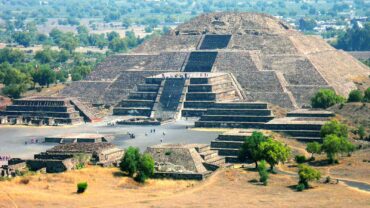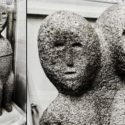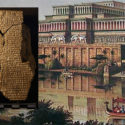Graham Hancock: Ancient Civilization Wiped Out by Massive Comet 22,000 Years Ago
Graham Hancock is a popular name on the list of archaeologists and researchers who dared to look at ancient history with a different view. He became the loudest voice in the argument against the accepted chronology of the development of human civilization. He presented evidence of how a massive celestial object completely wiped out a human civilization much older than known settlements.
Mr. Hancock proposed many alternative theories that might not please mainstream archeologists. For example, he said that some ancient structures such as the “Great Sphinx” were actually remnants of a much older stage of human civilization that existed before the end of the last Ice Age. He based his theory on the correlation between cultural and geological events between different sites as distant as Indonesia, Turkey, Egypt, and India. These indicate that a human civilization lived much earlier than it is claimed by scientists.

In other words, mankind had developed advanced civilizations long before the emergence of the Mesopotamian and Egyptian civilizations that mainstream archaeology believes were the very beginnings of human civilization.
In fact, Mr. Hancock proposed that ancient civilizations such as Egyptians, Mayans, and Mesopotamians had only inherited the knowledge of a much more advanced civilization that pre-dated them by possibly 6,000 years or more and which was destroyed by a great cataclysm. The same cataclysm that brought the last Ice Age to a dramatic end around 12,000 BC.
Magicians of the Gods
In his book “Magicians of the Gods,” Mr. Hancock mentioned traveling to different parts of the world, gathering evidence for a lost “ancestor” civilization, which he argues disappeared during a cataclysmic upheaval at the end of the last Ice Age due to a run-in with the broken shards of a massive comet. He suggested that this comet travels with the famous Taurid meteor shower that comes in late June to early July and again in late October to early November.

He argued that this particular meteor shower is filled with massive remnants of a massive comet that broke up for some unknown reason roughly 20,000 years ago, the shards of which, some as large as 2 km in diameter, collided with the North American and European ice sheets and brought about the apocalyptic “Younger Dryas” (around 12,900 to 11,700 years BP) phase of the Ice Age.
Graham Hancock is a popular name on the list of archaeologists and researchers who dared to look at ancient history with a different view. He became the loudest voice in the argument against the accepted chronology of the development of human civilization. He presented evidence of how a massive celestial object completely wiped out a human civilization much older than known settlements.
Mr. Hancock proposed many alternative theories that might not please mainstream archeologists. For example, he said that some ancient structures such as the “Great Sphinx” were actually remnants of a much older stage of human civilization that existed before the end of the last Ice Age. He based his theory on the correlation between cultural and geological events between different sites as distant as Indonesia, Turkey, Egypt, and India. These indicate that a human civilization lived much earlier than it is claimed by scientists.
In other words, mankind had developed advanced civilizations long before the emergence of the Mesopotamian and Egyptian civilizations that mainstream archaeology believes were the very beginnings of human civilization.
In fact, Mr. Hancock proposed that ancient civilizations such as Egyptians, Mayans, and Mesopotamians had only inherited the knowledge of a much more advanced civilization that pre-dated them by possibly 6,000 years or more and which was destroyed by a great cataclysm. The same cataclysm that brought the last Ice Age to a dramatic end around 12,000 BC.
Magicians of the Gods
In his book “Magicians of the Gods,” Mr. Hancock mentioned traveling to different parts of the world, gathering evidence for a lost “ancestor” civilization, which he argues disappeared during a cataclysmic upheaval at the end of the last Ice Age due to a run-in with the broken shards of a massive comet. He suggested that this comet travels with the famous Taurid meteor shower that comes in late June to early July and again in late October to early November.
He argued that this particular meteor shower is filled with massive remnants of a massive comet that broke up for some unknown reason roughly 20,000 years ago, the shards of which, some as large as 2 km in diameter, collided with the North American and European ice sheets and brought about the apocalyptic “Younger Dryas” (around 12,900 to 11,700 years BP) phase of the Ice Age.
Mr. Hancock wrote: “The impacts, from comet fragments a mile wide approaching at more than 60,000 miles an hour, generated huge amounts of heat which instantly liquidized millions of square kilometers of ice, destabilizing the Earth’s crust and causing the global Deluge that is remembered in myths all around the world.
A second series of impacts, equally devastating, causing further cataclysmic flooding, occurred 11,600 years ago, the exact date that Plato gives for the destruction and submergence of Atlantis. The evidence revealed in this book shows beyond reasonable doubt that an advanced civilization that flourished during the Ice Age was destroyed in the global cataclysms between 12,800 and 11,600 years ago
As per Mr. Hancock, this sudden re-emergence of cold was due to a comet that impacted the polar caps, triggering colossal tides and covering the atmosphere with dust for more than 1,000 years.

The researcher collaborated in different explorations, visiting locations as mysterious as the sacred site of Gunung Padang in Indonesia. There, he found the remains of columnar basalt that, according to him, belonged to a pyramid dating from the year 22,000 BC or even earlier.
According to him, those who survived (known to ancient cultures as ‘the Sages’, ‘the Magicians’, ‘the Shining Ones’, and ‘the Mystery Teachers of Heaven’) the cataclysms traveled the world in their ships to keep the signs of the dying civilization. They settled at Gobekli Tepe in Turkey, Baalbek in Lebanon, Giza in Egypt, ancient Sumer, Mexico, Peru, and Indonesia.
According to experts, Göbekli Tepe in Turkey is more than 9,600 years old and is the greatest evidence of the effects of a devastating scenario. According to Hancock, the area served for the survivors of the cataclysm to preserve, at least, some knowledge of the civilization that was annihilated with the intention of transmitting it to new generations.
The researchers say that it is no coincidence that the first traces of the re-emergence of civilization, in the form of the oldest known megalithic architecture, in addition to agricultural knowledge, occurred in Göbekli Tepe 11,000 years ago. This date coincides perfectly with the Younger Dryas and the return of a more pleasant global environment.
“Magicians of the Gods” also presents evidence that fragments of the comet reached ancient Egypt as well. There, an ancient cult in Heliopolis developed a way to preserve historical knowledge for the benefit of new generations in the form of astronomical schematics and monumental architecture.
Will the comet arrive again?
In 2015, Mr. Hancock claimed in his article, published in the Daily Mail that an earth-destroying comet was heading to Earth in 20 years, which is 13 years from now. He wrote: “These Magicians left a message for us — not a metaphorical, spiritual message, but a direct and urgent warning. What happened before can happen again; what destroyed their world can destroy ours.”
He warned that the impact of the comet would be a thousand times worse than the detonation of every nuclear weapon on the planet — a collision with the remnants of a comet big enough to end all life as we know it



